
New Zealand was the last major land area outside the polar regions to be occupied by humans and New Zealanders have always been concious that their ancestors came from somewhere else.
Issue information
Some came to escape unpleasant living conditions in their homelands, while others were primarily attracted by what this country had to offer. For the last half-century at least, New Zealand had been one of the world's most appealing destinations for migrants. One reason for the popularity was the impression that these islands were relatively unspoiled and uncluttered. This was true largely because of their remoteness from the world's big population centres.
The occupation of this land began a thousand years ago and involved, perhaps, a few thousand migrants who braved the south-west Pacific Ocean to get to New Zealand from Central Polynesia. For centuries Māori descendants of these first immigrants were completely cut off from the outside world.
European settlement began seriously in New Zealand around 1815 and, thanks to assisted immigration as well as to the gold rushes of the 1860s, the non-Māori population had reached half a million by the 1880s. The number of migrants fluctuated from then, along with economic conditions, but the overall population grew steadily. Immigrants from Great Britain and the former British Empire were not restricted, but all others faced tight controls. The policy of favouring British migrants gradually changed after the Second World War. Humanitarian considerations saw more southern and non-Europeans admitted, while restrictions on the entry of New Zealanders to Britain led to the removal of the automatic right of British people to come here. Now the important consideration was that immigrants would 'fit in' to New Zealand society.
In 1987 the Immigration Act was passed and New Zealand evaluated intending immigrants on the basis of personal merit, which was assessed primarily in terms of the skills the country needed and the assets the migrants had to bring with them. There was a rapid increase in the numbers of migrants coming from Hong Kong, Taiwan and Malaysia. In the 1990s, a point system opened up immigration even further and by 1995 Taiwan had replaced Britain as the largest country of origin.
Today, almost everyone living in New Zealand is descended from someone who arrived within the last two centuries.
Product Listing for A New Beginning - The Millenium Series Part Two
| Image | Title | Description | Price |
|---|---|---|---|
 |
Single Stamp |
Single 40c 'The Māori' gummed stamp. The first intentional immigrants travelled to New Zealand from Hawaiki, around 1,000 - 1,200 years ago. Skilled at navigating between small islands, they used large double-hulled canoes with woven sails. The first colonists may have been all-male crews who were blown off course but they were followed by parties of intentional settlers. These migrants probably braved the long and dangerous ocean voyage because conditions on their tiny home island had become intolerable due to war or the pressure of an increasing population on food supplies. While the islands of New Zealand were large and rich in resources, many subtropical crops grew poorly here and the migrants must have taken some time to adapt to their new surroundings. After a few centuries, contact with the migrants' home life was lost. By this time indigenous plants and bird life, such as flax and the giant moa, were being utilised. As the population grew, migrant groups moved inland and south from the initial area of settlement in the north of the North Island. In the South Island cultivated plants could not survive and many of the staple food sources, such as seals and shellfish, were found in the ocean. |
$0.40 |
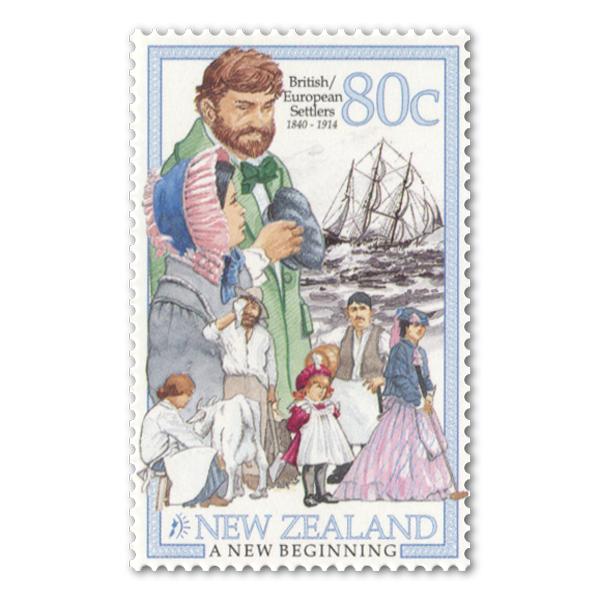 |
Single Stamp |
Single 80c 'British / European Settlers 1840 - 1914' gummed stamp. Fifty million people left Europe to live in the New World in the 19th century. Most of them went to North America, perhaps one percent came to New Zealand. This country appealed to the citizens of overcrowded and industrialised countries, but it was literally at the end of the earth and costly in both time and money to reach. Many of the migrants would not have come here had they not been helped to do so. The first wave in the 1840s, was bought out by the privately owned New Zealand Company in an unsuccessful attempt to reinvent pre-industrial English society. These first organised settlers were reinforced in the 1850s by migrants attracted by the new provincial governments. The largest ever influx of new settlers including about 100,000 assisted immigrants, arrived in the 1870s. With the end of the New Zealand Land Wars, and financed by revenue from gold, the governments of Julius Vogel and his successors persuaded many British rural and domestic workers to seek a better life in the Antipodes. Most found it. |
$0.80 |
 |
Single Stamp |
Single $1.00 'Fortune Seekers 1800 - 1920' gummed stamp. Many people have come to New Zealand hoping to make their fortunes. In the half-century before these islands became a British colony in 1840, they came to exploit the easily accessible seals, whales, trees and flax. The biggest rush was the quest for gold iin the 1860s. Many men who travelled to California in 1849 and (especially) Victoria in 1851 came to Central Otago in 1861 with an influx of more than 200,000 immigrants during the 1860s, including Chinese gold prospectors who were imported to work in the fields. Some then moved on to Westland in 1865 and Thames in 1867. Immigrant’s from the Dalmatian coast of Croatia came to work the kauri gumfields of Northland and the Coromandel Peninsula. Few became rich, but many stayed and took up farming or other trades. |
$1.00 |
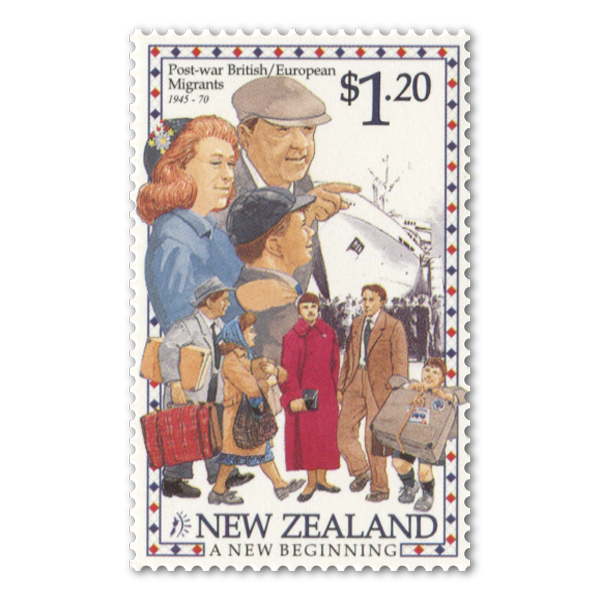 |
Single Stamp |
Single $1.20 'Post War British / European Migrants 1945 - 1970' gummed stamp. In the first half of the 20th century there were several periods of substantial assisted immigrants from Britain when the New Zealand economy was growing. After the Second World War New Zealand's demand for labour was greater than ever, and many were keen to leave behind the cramped and austere conditions at home. Nearly 100,000 assisted immigrants came from Britain between 1945 and 1975, many in family groups, most either at no cost to themselves or for next to nothing. More than 10,000 assisted immigrants also came from other countries, particularly the Netherlands, which was even more crowded and impoverished than Britain. Dutch migrants were seen as hard-working and likely to be easily absorbed into New Zealand society, and most lived up to these expectations. From the late 1930s significant numbers of refugees and people displaced by war were accepted by New Zealand goverments. Successive groups of Germans, Poles, Greeks, Yugoslavs and Hungarians had arrived by the late 1950s, none more than a couple of thousand strong. |
$1.20 |
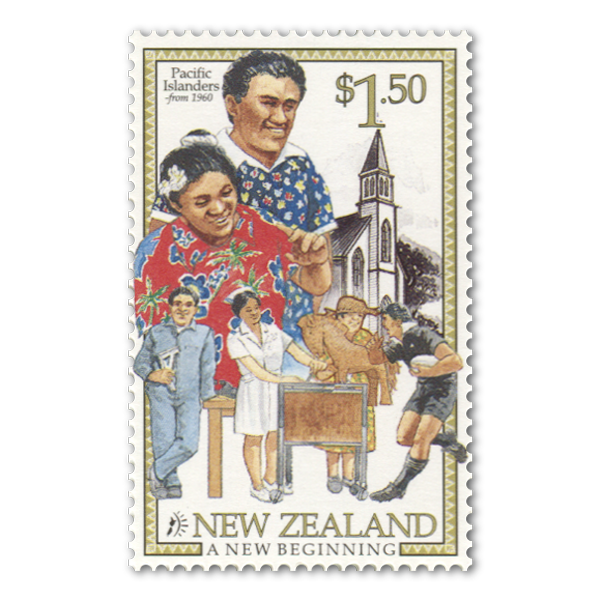 |
Single Stamp |
Single $1.50 'Pacific Islanders from 1960' gummed stamp. Very few migrants from the Pacific Islands followed the ancestors of the Māori to New Zealand until after the Second World War. Although from the turn of the century residents of the Cook Islands and Niue were New Zealand citizens, they were kept at home by a system of exit permits. New Zealand's wartime need for factory and domestic workers saw the first modification of this policy of exclusion when women were bought in from the Cook Islands. The continuing post-war demand for labour ensured that the door remained open and the need for workers to perform ‘unskilled’ work after World War II saw the number of Pacific Island immigrants rise to 47,000 in 1971. Family reunification was a legitimate reason for many to come here and until the mid 1970s the illegal presence of many Pacific Islanders was overlooked because of their contributions to the workforce. By 1996, the rate of migration from the Pacific was slowing and more than half the 200,000 people of Pacific Island descent in New Zealand were born here. Two-thirds lived in the Auckland urban area and many of the remainder in Porirua, north of Wellington. Half were Western Samoans, who gained entry rights after their country became independent in 1962. Many Tongans and Fijians (particularly those of Indian descent) also became New Zealand residents. |
$1.50 |
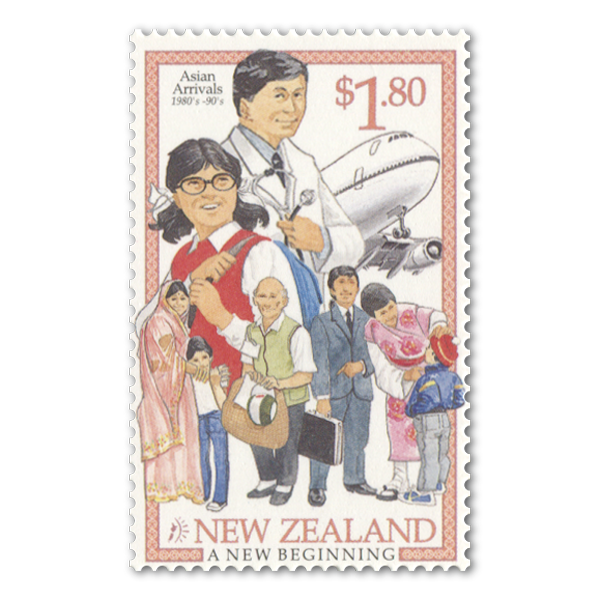 |
Single Stamp |
Single $1.80 'Asian Arrivals 1980s and 1990s' gummed stamps. By the Second World War there were significant Indian communities in Auckland and in the market gardening areas around Pukekohe and Taradale. From this time there was an increased willingness to allow in Indian and Chinese women and children on family reunification grounds, and both groups grew rapidly. From 1987, New Zealand had become home to highly skilled affluent migrants from North, South and South-East Asia. By 1996, 44,000 New Zealanders identified themselves as Indian and 82,000 as Chinese. The numbers of the latter had risen greatly since the Immigration Act 1987 made skills and wealth the key criteria for admission to this country. New Zealand's Asian population had nearly doubled in the 1990s, with substantial numbers of Koreans and Japanese also gaining entry and by 1996 13,000 Koreans and 7,000 Japanese identified themselves as New Zealanders. In marked contrast were the 10,000 South-East Asian refugees who had settled in New Zealand since 1975. Most had come from Indo-China and many remain in clearly defined communities. Together these groups formed a part of the population that, in just five years, had increased to the point where they were nearly as numerous as the Pacific Island part of the population. Like their predeccessors, these groups of recent Asian immigrants had both enriched New Zealand society and suffered some antagonism from longer established groups. This has always been the fate of immigrants in New Zealand as in other countries. |
$1.80 |
 |
First Day Cover | First day cover with stamps affixed. Cancelled on the first day of issue. | $7.20 |
| Presentation Pack | Presentation pack containing a selection of stamp products from the issue and further information on the theme of the stamps. | $8.50 | |
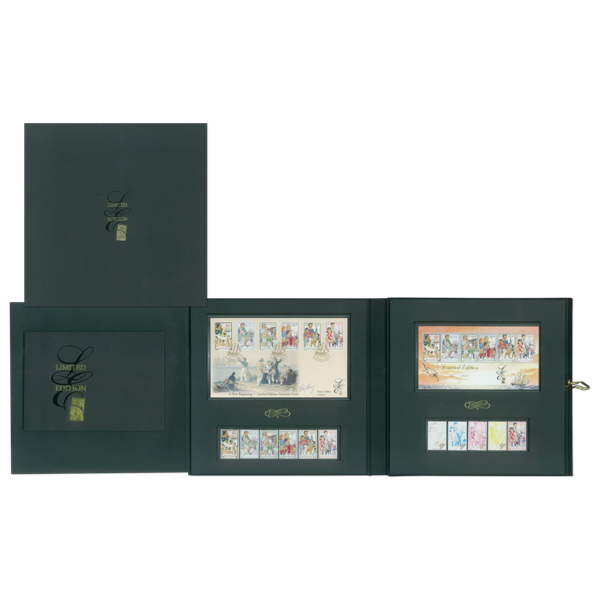 |
Limited Edition | Limited edition collectable containing exclusive stamp products not available anywhere else. | $135.00 |
Technical information
| Date of issue: | 18 March 1998 |
|---|---|
| Number of stamps: | Six |
| Denominations and designs: | 40c The Māori, 80c British/European Settlers, $1.00 Fortune Seekers, $1.20 Post-war British/European Migrants, $1.50 Pacific Islanders, $1.80 Asian Arrivals |
| Stamps and first day cover designed by: | Terry Crilley, Blenheim, New Zealand |
| Printer and process: | Southern Colour Print, Dunedin, New Zealand by lithography |
| Number of colours: | Four process colours |
| Stamp size and format: | 28mm x 44mm (vertical) |
| Paper type: | 104gsm red phosphor coated Litho stamp paper |
| Number of stamps per sheet: | 50 stamps per sheet |
| Perforation gauge: | 13.6 |
| Cost of unadressed first day cover: | $7.20 |
| Special blocks: | Plate/imprint, positional or value blocks could be obtained by purchasing at least six stamps. Colour blocks ('traffic lights') were included in plate blocks. Barcode blocks were available in both A and B formats. |
| Period of sale: | These stamps remained on sale until 18 March 1999. |


